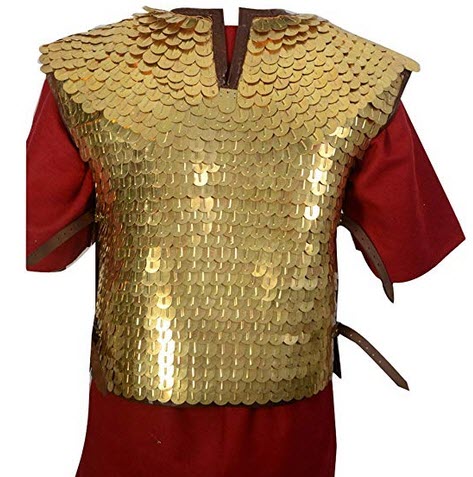Contents
The lorica squamata was a type of scale armor used by Roman soldiers. It consisted of numerous small scales wired to each other and fastened onto a backing fabric. This distinguishes the lorica squamata from the lamellar armor and the locking scale armor, since none of these armor types need backing.
Regrettably, no complete lorica squamata have been found, so what we know about them is largely derived from fragments and from artistic depictions of Roman soldiers. Armor fragments, including complete scales, are a rather common find for archaeologists and have been discovered even in non-military dig sites.
 In art, a wide range of army professionals have been depicted wearing lorica squamata, not just regular legionaries but also auxiliary infantry men, centurions and cavalry troops. Specialists such as standard bearers and musicians have also been depicted with this type of armor.
In art, a wide range of army professionals have been depicted wearing lorica squamata, not just regular legionaries but also auxiliary infantry men, centurions and cavalry troops. Specialists such as standard bearers and musicians have also been depicted with this type of armor.
When?
The lorica squamata was used during the Roman Republic and the Roman Empire.
Configuration
- The lorica squamata consisted of small metal scales (the squamae) sewn to a fabric backing.
- The scales were made from iron or bronze. Sometimes the same shirt would contain both iron and bronze scales.
- Each individual scale was thin, but since the scales overlapped in every direction it resulted in excellent protection.
- The scales were wired or laces together in horizontal rows. These rows were then laced or sewn onto the backing.
- The size of the scales varied. The smallest ones we know of were almost 1 cm long and less than 7 mm wide, while the biggest ones were 8 cm long and roughly 5 cm wide. Generally speaking, the scales in one individual shirt would be of the same size, but the scales of two different shirts could vary a lot from each other.
- Scales came in a variety of shapes, including slightly domed ones and scaled with a raised edge or midrib. It was common for the scales to have rounded bottoms, but some were pointy or flat instead.
- Each scale had holes in it to fasten it. Four holes was the minimum, with some scales having up to a dozen holes. There needed to be holes at each side for wiring the scale to the adjacent scales the row, and also a hole or two at the top to fasten the scale to the backing. Some scales would also have one or more holes at the bottom to secure the scales even better, either to the backing or to other scales.
Variants
One unusual variant is the one where a lorica hamata is used as backing. This gives the bearer increased protection, but the armor becomes much heavier and also more expensive.
